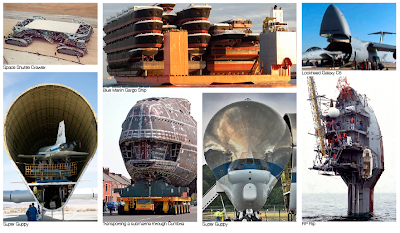 |
| Basic site logistics |
Building sites are often served by large loads on articulated lorries, closely followed by sub-contractor's transit vans containing people, tools, components and materials. Everything which goes in to making a building, comes through this logistical bottle-neck. When all the journeys and deliveries are added up, the total number of supplies and deliveries can be surprisingly huge. The logistical processes in supplying a building site have a significant impact on programme, work-hours and energy consumption and waste.
It is important to consider the logistical restrictions (or opportunities) when setting out to design any building, to economise on the number of loads required. This in turn assists to:
- Potentially save energy
- Economise on build time and offer opportunities to resolve critical path items
- Economise on the labour force, or make it more efficient
- Potentially save project costs
- Offer opportunities on waste management
 |
| Standard construction logistics |
Logistics is a key part of innovation in the building industry and can be used as a means to promote creative thinking in project design. When thinking about standard sized materials or prefabricated components, it is useful to consider the standard logistical solutions, and opportunities for going beyond the norm.
 |
| Payload options, from a one person lift to the Super Guppy |
STG are specialists in the movement of large, oversized items and experts in construction logistics. Their involvement in a project usually begins with a transport study to investigate the logistical restrictions involved in transporting large objects to site, and what the options might be. The key consideration with most projects is the available space to move in and weight restrictions.
 |
| STG - Specialists in the movement of special items or large loads |
Perhaps our standard logistical patterns within the building industry play a key role in the commonality of building design; why buildings look identifiable as buildings and distinct (by their choice of materials and construction processes) from cars or boats.
 |
| Logistics plays an important part in establishing why building design conforms to a specific set of rules |
It is informative to see what the processes are in different industrial sectors, and to find out if there are any advantages for the building industry. The heroic and often crazy responses to some of the logistical challenges presented in other industrial sectors sparks the imagination and are good references for innovation. Logistical issues in relation to building projects can be an adventure in themselves, and so deserve full consideration in the design of projects.
 |
| Logistical challenges |
